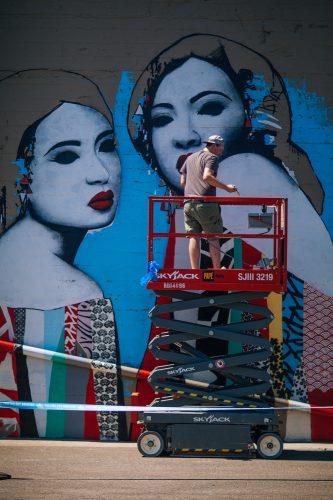
Just after I moved to Eugene about a year and a half ago, Eugene Weekly ran a story titled “Art: It Could Happen Here” [EW, Feb. 4, 2016]. Written after the city-subsidized Jacobs Gallery had closed, the article suggested that Eugene might have to change its slogan from “A Great Place for the Arts and Outdoors” to “Eugene, A City Where People Go Outdoors.” Had I moved to a town without art?
This summer proved that art can happen here.
It happened big and all at once but not inside any gallery space. It went up “festival style,” which is, I learned at the August First Friday ArtWalk, what it’s called when different muralists are invited to work simultaneously.
As a result of the city-led project, an impressive amount of art suddenly appeared downtown in July, and the images are as varied as the artists who came to participate.
They arrived from as far as France and Argentina, Brazil and China, joining artists from here in Eugene. Some of their works are brilliantly colored; some are stenciled in black and white. Large murals can be seen from a distance; others are tucked into alleys where you can’t stand back far enough to take everything in all at once. Smaller works sometimes blend seamlessly into the street environment so they aren’t quickly recognizable as art.
One of my favorite works was painted by Hyuro, an artist from Spain, on the wall of The Kiva, 125 W. 11th Avenue. It depicts in four panels a plant being reborn in a woman’s hands. Another I particularly like is by Hush, from England, who painted two wall-sized geishas at Falling Sky Brewing House, 1334 Oak Alley, in a style that reminds me of modernist painter Gustav Klimt.
This is only the beginning, for the city’s 20x21EUG mural project promises to bring 20 murals to downtown by 2021, in time for the World Track and Field Championships. Art is indeed happening here. Eugene’s slogan is safe once more! Though it might be apt this time to delete the “and” in our slogan so it reads “Eugene, The Greatest City for the Arts Outdoors.”
Art outdoors is great, but it is different than art indoors. It doesn’t switch out every month as in a gallery, so we are in effect stuck with the one “show.” And you can’t protect art outdoors the same way you can conserve works inside.
The mural project committee offered participating artists a protective coating for their work, but not all artists wanted their art protected from the elements or graffiti. Blek le Rat from France said he thought of graffiti and street art as belonging to the same family. His work had, by the arrival of August’s First Friday, already been tagged multiple times. Though he apparently didn’t mind, the tags were erased from his artwork.
Blek and Dan Witz from Brooklyn were introduced at the ArtWalk as pioneers of the street art genre. Though the two have long admired each other’s work and were glad to meet in Eugene for the first time, their individual attitudes toward the project differed.
Blek thought the project signified a positive shift in the way street art is viewed. Witz was not as ready to go along with what had been planned. He works with smaller formats and placed some of his art on walls that hadn’t been preapproved. He put up approximately 20 smaller works around town — and by the time of the ArtWalk tour, several had already been removed.
The relationship between street art and graffiti is still blurred. Certainly not all graffiti has value like that seen in the art market by the late Jean-Michel Basquiat, whose 1982 painting recently sold for $110.5 million.
The protective coating offered was created to deter graffiti. Similarly, Philadelphia’s mural program was founded, in part, as an anti-graffiti program. I mention Philadelphia because its program, Mural Arts Philadelphia, has put more than 3,800 artworks on the sides of the city’s buildings, making the City of Brotherly Love perhaps a more realistic contender for the title of “World’s Greatest City for the Arts Outdoors.”
Despite street art’s acceptance in the art world and on the streets of Eugene, those who mark walls that don’t belong to them are committing an offense. That’s why Blek le Rat may have been impressed with the project: It was all above board. The artists were not at all like rats who scurry in darkness, painting quickly so as not to be caught.
Still, that’s what the genre in part is known for: risk, danger and social commentary. Perhaps that is why the crowd that gathered on First Friday chuckled appreciatively when mural guide Paul Godin told them the project committee’s members weren’t yet certain where Dan Witz placed all his artworks.